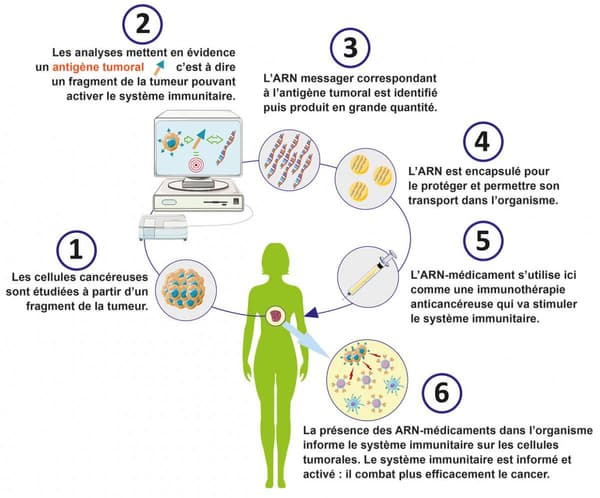Messenger ribonucleic acid, better known as messenger RNA or mRNA. This term became very popular with the Covid-19 pandemic, because it is the name of the molecule that made it possible to quickly create effective vaccines against this virus, which spread across the planet in a few weeks.
But before being used against SARS-CoV-2, messenger RNA had already been studied for several years and was considered, in particular, as a potential cancer treatment. The pandemic has had the positive side effect of allowing labs to move faster on this issue.
US laboratories Moderna and Merck announced last Wednesday that they had reached an agreement to jointly develop and market an mRNA vaccine against skin cancer. Those responsible for BioNTech have raised the possibility that an mRNA vaccine against cancer will be available “before 2030”.
What is messenger RNA again?
The mRNAs “serve as a template during the manufacture of proteins,” explains Inserm. These molecules are produced from our DNA, it is “a photocopy of the page of the genome where the instructions to produce a certain protein are written”. Thus, an mRNA is, in a way, a blueprint passed on to a cell, telling it how to make the protein it needs.
In the context of vaccines against Covid-19, an mRNA that codes for the Spike protein was used and injected, because it is this protein that allowed the virus to enter our cells.
After the vaccine, with the blueprint given by the mRNA, “our cells then make this protein and ‘present’ it on their surface. The immune system recognizes it as if it were carried by the virus itself and activates the defense mechanisms and memory response,” explains Inserm. Therefore, the immune system will be able to recognize the virus if the organism becomes infected in the future.
The same technique as against Covid-19
When we talk about an mRNA vaccine against cancer, we are not only talking about preventive techniques, as is the case with Covid-19, but also about curative methods: it is not about preparing the system for a possible infection, the disease. It’s already there and you have to fight it.
However, mRNA is still used by the same principle: “to ensure that representative samples of cancer cells are exposed to immune cells,” explains the ARC Foundation for Cancer Research.

“We take cells from the tumor and we will study the sequences, that is, the identity card of these tumors”, explains Alain Ducardonnet, cardiologist and health consultant for BFMTV.
“Then we will synthesize the mRNA and inject it into the body, and there we will somehow give the information to the immune cells so that they specifically attack the images that the mRNA brings. Then they will specifically attack the tumor cells.”
Hardest cancer to catch
The whole difficulty with cancer lies in finding the protein to reproduce in order to successfully fight the tumor. Viruses are thus “carriers of certain characteristics that indicate to the immune system that they are enemies”, explains in ARTE Mustafa Diken, an immunologist.
But “cancer is different because cancer cells come from our own cells and normally, with the naked eye, the immune system cannot always identify what an enemy is,” he explains.
In fact, it is necessary “to guarantee that this orientation cannot mount the immune system against healthy cells that would also express the protein encoded by the mRNAs of the vaccine”, emphasizes the ARC Foundation. Therefore, the researchers are trying to target “some of the genetic mutations present in cancer cells” that “directly affect the nature of the proteins produced by these cells.”
On the other hand, each cancer acts differently and affected individuals have a different immune response, leading to a demand for personalized responses.
mRNA associated with other methods
Several dozen studies are currently underway on the topic, as the pandemic has brought the mRNA method to light and increased the amount of funding devoted to it.
“Some RNA drugs in development are designed to directly attack the fundamental processes of cancer: proliferation, acquisition of resistance to treatment, formation of metastases, etc.,” explains the League Against Cancer, “others target the permissive environment rather than supports the development of cancer and acts, for example, by activating the anti-cancer immune response”.
It is still very difficult at the moment to give a launch date for a treatment and mRNA, although revolutionary in its approach, is not a silver bullet and may not be enough on its own. Immunotherapies “therefore, obviously, in the long term, could be associated with potential vaccine strategies. Furthermore, they are already integrated into current cancer vaccination trials,” writes the Arc Foundation.
Beyond cancer, mRNA treatments could “allow personalized management of a large number of diseases, such as genetic diseases in particular”, explains Palma Rocchi, biologist, director of research at Inserm. “It is a true revolution for the medicine of tomorrow.”
Source: BFM TV

